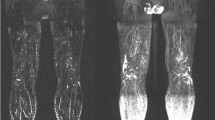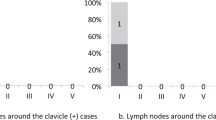Abstract
Purpose
The purpose of the present study was to analyse the performance of non-contrast MR lymphography for the classification of primary lower limb lymphoedema in 121 consecutive patients with 187 primary lower limb lymphoedemas.
Materials and methods
121 consecutive patients with clinically diagnosed primary lower limb lymphoedema underwent non-contrast MR lymphography with a free-breathing 3D fast spin-echo sequence with a very long TR/TE (4000/884 ms). MR examinations were retrospectively reviewed for severity of lymphoedema (absent, mild, moderate, severe) and characteristics of inguinal lymph nodes and iliac and inguinal lymphatic trunks graded as aplasic (no lymph nodes or lymphatic trunks), hypoplasic (less lymph nodes or lymphatic trunks), normal and hyperplasic (more lymph nodes or more and/or dilated trunks).
Results
There was an excellent correlation between clinical stage and severity of lymphoedema (Cramer’s V of 0,73 (p < 0.001)). Differentiation was feasible between inguinal lymphatic vessel aplasia (21%), hypoplasia (15%), normal pattern (53%) and hyperplasia (11%).
Severe lymphoedema was observed in 46% of aplasic patterns and in 37% of hyperplasic patterns, but in only 15% of hypoplasic patterns and never observed in normal patterns (p < 0.001).
Conclusion
Non-contrast MR lymphography is able to classify primary lower limb lymphoedemas into hyperplasic, aplasic, hypoplasic and normal patterns.
Key Points
• Non-contrast MR lymphography is able to classify primary lower limb lymphoedemas.
• Lymphoedema can be classified in hyperplasic, aplasic, hypoplasic and normal patterns.
• Non-contrast MR lymphography can optimize clinical management of primary lower limb lymphoedemas.





Similar content being viewed by others
References
Cho S, Atwood JR (2002) Peripheral edema. Am J Med 113:580–586
Allen EV (1934) Lymphedema of the extremities. Classification, etiology and differential diagnosis: a study of three hundred cases. Arch Intern Med 54:606–624
Petrek JA, Pressman PI, Smith RA (2000) Lymphedema: current issues in research and management. CA Cancer J Clin 50:292–307
Kinmonth JB (1957) Primary lymphoedema. Clinical and lymphangiographic studies of a series of 107 patients in which the lower limbs were affected. Br J Surg 189:1–9
Campisi C, Davini D, Bellini C et al (2006) Lymphatic microsurgery for the treatment of lymphedema. Microsurgery 26:65–69
Becker C, Assouad J, Riquet M, Hidden G (2006) Postmastectomy lymphedema: long-term results following microsurgical lymph node transplantation. Ann Surg 243:313–315
Olszewski WL (2013) Lymphovenous microsurgical shunts in treatment of lymphedema of lower limbs: a 45-year experience of One surgeon/One center. Eur J Vasc Endovasc Surg 45:282–290
Tammela T, Saaristo A, Holopainen T et al (2007) Therapeutic differentiation and maturation of lymphatic vessels after lymph node dissection and transplantation. Nat Med 13:1458–1466
Lähteenvuo M, Honkonen K, Tervala T et al (2011) Growth factor therapy and autologous lymph node transfer in lymphedema. Circulation 123:613–620
Witte CL, Witte MH, Unger EC (2000) Advances in imaging of lymph flow disorders. RadioGraphics 20:1697–1719
Weissleder H, Weissleder R (1988) Lymphedema: evaluation of qualitative and quantitative lymphoscintigraphy in 238 patients. Radiology 167:729–735
Ruehm SG, Schroeder T, Debatin JF (2001) Interstitial MR lymphography with gadoterate meglumine: initial experience in humans. Radiology 220:816–821
Lohrmann C, Foeldi E, Speck O, Langer M (2006) High-resolution MR lymphangiography in patients with primary and secondary lymphedema. AJR Am J Roentgenol 187:556–561
Mitsumori LM, McDonald ES, Wilson GJ, Neligan PC, Minoshima S, Maki HM (2015) MR lymphangiography: How I do it. J Magn Reson Imaging 42:1465–1477
Lu Q, Delproposto Z, Hu A et al (2012) MR lymphography of lymphatic vessels in lower extremity with gynecologic oncology-related lymphedema. PLoS One 7:e50319
Liu NF, Lu Q, Jiang ZH, Wang CG (2009) Anatomic and functional evaluation of the lymphatic and lymph nodes in diagnosis of lymphatic circulation disorders with contrast magnetic resonance lymphangiography. J Vasc Surg 49:980–987
Case TC, Witte CL, Witte MH, Unger EC, Williams WH (1992) Magnetic resonance imaging in human lymphedema: comparison with lymphangioscintigraphy. Magn Reson Imaging 10:549–558
Liu NF, Wang CG (1998) The role of magnetic resonance imaging in diagnosis of peripheral lymphatic disorders. Lymphology 31:119–127
Aström KGO, Abdsaleh S, Brenning GC, Ahlström KH (2001) MR imaging of primary, secondary, and mixed forms of lymphedema. Acta Radiol 42:409–416
Consensus Document of the International Society of Lymphology (2009) The diagnosis and treatment of peripheral lymphedema. Lymphology 42:51–60
Hadjis NS, Carr DH, Banks L, Pflug JJ (1985) The role of CT in the diagnosis of primary lymphedema of the lower limb. AJR 144:361–364
Witte CL, Witte MH (1998) Physiology and imaging of the peripheral lymphatic system. In: Moore WS (ed) Vascular surgery, 5th edn. Saunders, Philadelphia, pp 808–828
Witte MH, Witte CL (1992) Massive obesity simulating lymphedema. N Engl J Med 327:1927
Duewell S, Hagspiel KD, Zuber J, von Schulthess GK, Bollinger A, Fuchs WA (1992) Swollen lower extremity: role of MR imaging. Radiology 184:227–231
Mihara M, Hara H, Hayashi Y et al (2012) Pathological steps of cancer related lymphedema histological changes in the collecting lymphatic vessels after lymphadenectomy. PLoS ONE 7:e41126
Vaqueiro M, Gloviczki P, Fisher J, Hollier LH, Schirger A, Wahner HW (1986) Lymphoscintigraphy in lymphedema: an aid to microsurgery. J Nucl Med 27:1125–1130
Maegawa J, Mikami T, Yamamoto Y, Satake T, Kobayashi S (2010) Types of lymphoscintigraphy and indications for lymphaticovenous anastomosis. Microsurgery 30:437–442
Koehler PR (1968) Complications of lymphography. Lymphology 1:116–120
Notohamiprodjo M, Weiss M, Baumeister RG et al (2012) MR lymphangiography at 3.0T: correlation with lymphoscintigraphy. Radiology 264:78–87
Olszewski WL, Liu NF (2013) Magnetic resonance lymphography (MRL). Point and counter point. Lymphology 46:202–207
Lu Q, Xu J, Liu N (2010) Chronic lower extremity lymphedema: a comparative study of high-resolution interstitial MR lymphangiography and heavily T2-weighted MRI. Eur J Radiol 73:365–373
Liu N, Wang C, Sun M (2005) Noncontrast three-dimensional magnetic resonance imaging vs lymphoscintigraphy in the evaluation of lymph circulation disorders: a comparative study. J Vasc Surg 41:69–75
Takahashi H, Kuboyama S, Abe H, Aoki T, Miyazaki M, Nakata H (2003) Clinical feasibility of non-contrast enhanced magnetic resonance lymphography of the thoracic duct. Chest 124:2136–2142
Arrivé L, Azizi L, Lewin M et al (2007) MR lymphography of abdominal and retroperitoneal lymphatic vessels. AJR Am J Roentgenol 189:1051–1058
Derhy S, El Mouhadi S, Ruiz A, Azizi L, Menu Y, Arrivé L (2013) Non-contrast 3D MR lymphography of retroperitoneal lymphatic aneurysmal dilatation: a continuous spectrum of change from normal variants to cystic lymphangioma. Insights Imaging 4:753–758
Yamamoto T, Yoshimatsu H, Narushima M, Yamamoto N, Hayashi A, Koshima I (2015) Indocyanine Green Lymphography findings in primary leg lymphedema. Eur J Vasc Endovasc Surg 49:95–102
Acknowledgments
Julien Bouvier for technical assistance.
Author information
Authors and Affiliations
Corresponding author
Ethics declarations
Guarantor
The scientific guarantor of this publication is Lionel Arrivé M.D..
Conflict of interest
The authors of this manuscript declare no relationships with any companies whose products or services may be related to the subject matter of the article.
Funding
The authors state that this work has not received any funding.
Statistics and biometry
One of the authors, Benjamin Dahan, has significant statistical expertise.
Ethical approval
Institutional Review Board approval was obtained.
Informed consent
Written informed consent was waived by the Institutional Review Board.
Methodology
• retrospective
• observational
• performed at one institution
Rights and permissions
About this article
Cite this article
Arrivé, L., Derhy, S., Dahan, B. et al. Primary lower limb lymphoedema: classification with non-contrast MR lymphography. Eur Radiol 28, 291–300 (2018). https://doi.org/10.1007/s00330-017-4948-z
Received:
Revised:
Accepted:
Published:
Issue Date:
DOI: https://doi.org/10.1007/s00330-017-4948-z




